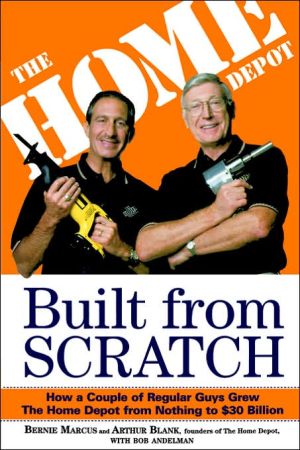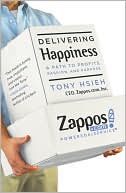Built from Scratch: How a Couple of Regular Guys Grew the Home Depot from Nothing to $30 Billion
One of the greatest entrepreneurial success stories of the past twenty years\ When a friend told Bernie Marcus and Arthur Blank that "you've just been hit in the ass by a golden horseshoe," they thought he was crazy. After all, both had just been fired. What the friend, Ken Langone, meant was that they now had the opportunity to create the kind of wide-open warehouse store that would help spark a consumer revolution through low prices, excellent customer service, and wide availability of...
Search in google:
This firsthand account from the two "regular guys" who built the profitable Home Depot empire really delivers with a blend of irreverent candor and practical advice. Marcus and Blank explain how seemingly bad circumstances in both of their careers resulted in the brilliantly branded Atlanta-based home improvement operation that would eventually mushroom into a national powerhouse. Plus they even dish on some of the Home Depot's main competitors and its inside characters. The Wall Street Journal - James R. Hagerty Built From Scratch, the founders own account, is far more fun to read than Inside Home Depot, written by Chris Roush, a journalist who was denied access to many of the insiders. The founders' book gives only their viewpoint. It was ghost-written by Bob Andelman, who isn't known for restraining the vanities of his subjects.
"We Take Care of the Customer and Each Other"\ You want a formula for success? Take two Jews who have just been fired, add an Irishman who just walked away from a bankruptcy and an Italian running a no-name investment banking firm. Add—then subtract—Ross Perot. Lease space from a shrinking discount chain, fill a space the size of a football field full of hardware (and a few hundred empty boxes), and you've got a company.\ At least that's the way we did it.\ *\ • *\ The creation of The Home Depot began with two words in the spring of 1978: "You're fired!"\ Twenty years ago, we were two out-of-work executives. Our situation was not a lot different than millions of others who were shown the door. We had little in the way of capital and faced some daunting personal and legal challenges as we tried to get our careers back on track.\ In our early years, we lived on the edge, with no balance sheet and a lack of financing. It took great romancing to establish the vendor base necessary to open and maintain the broad product selection for which we quickly became known. We were always pushing boundaries beyond where our industry's conventional wisdom suggested we could go.\ And it paid off: In just twenty years, our company, The Home Depot, has multiplied exponentially from four stores in Atlanta to 775 stores, 160,000 associates, and $30 billion in sales. Almost all of our growth has come from internal expansion and very little through acquisition. How did we and our associates do it?\ Building The Home Depot was a tough, uphill battle from the day we started in a Los Angeles coffee shop shortly after we were fired. No one believed we could do it, and very few people trusted our judgment. Or they trusted our judgment, but just didn't think the whole concept of a home improvement warehouse with the lowest prices, best selection, and best service was going to work. They certainly didn't realize that what we were planning would turn out to be a revolution in the retail business.\ While we want to tell the story of The Home Depot because it's a great entrepreneurial tale, our larger goal is to convey what we learned along the way about customers, associates, competitors, growing a business, building a brand, and many other topics everyone in business needs to know.\ We're two regular guys from similar modest personal backgrounds and religious orientation who were given a strong drive to succeed by our respective parents. The values that form the core of The Home Depot's business philosophy are bigger than one person. They developed from our families as well as from key business experiences in the early days of our careers.\ This book is the story of that virtually unparalleled growth and the values and culture that nourished it.\ But we're not a company that's just about numbers. The numbers are important as a measure of our success. But we've attained them because of a culture that is agile and flexible enough to change direction as quickly as events demand it. When something isn't working in our stores, we don't keep doing it the wrong way simply because the rules say to do it that way. Instead, we do it the right way and change the rules. We do things because they're the right things to do for our customer.\ A set of eight values has been our bedrock for the past twenty years. Although they were not put in writing until 1995, these values—the basis for the way we run the company—enabled us to explode across the North American landscape and will be the vehicle for reaching our ambitious goals in the international marketplace.\ We're only as good as our people—especially the men and women working in our stores every day. If the front line isn't absolutely committed to the cause, we can't win. That's why we believe a sure way of growing this company is to clearly state our values and instill them in our associates. Values are beliefs that do not change over time; they guide our decisions and actions. They are the principles, beliefs, and standards of our company. We call this process of enculturation "breeding orange."\ In summary, we care about the customer and we care about each other. As you'll see throughout this book, our values are not platitudes that are dead on arrival on a lobby wall plaque, but are the spine that shapes the way we do business. These are The Home Depot's core values, although they are so universal that they should apply to every company:\ Excellent customer service. Doing whatever it takes to build customer loyalty.\ Taking care of our people. The most important reason for The Home Depot's success.\ Developing entrepreneurial spirit. We think of our organizational structure as an inverted pyramid: Stores and customers are at the top and senior management is on the bottom.\ Respect for all people. Talent and good people are everywhere, and we can't afford to overlook any source of good people.\ Building strong relationships with associates, customers, vendors, and communities.\ Doing the right thing, not just doing things right.\ Giving back to our communities as an integral part of doing business.\ Shareholder return. Investors in The Home Depot will benefit from the money they've given us to grow our business.\ Our values empower people to be their best. If we can implant a value system that lets them apply their basic goodness and ingenuity to The Home Depot and its customers, that's all we need to succeed. That will allow them to do all the right things without us having to constantly tell them.\ Nobody loves a company. A company is just a sign. Nobody loves brick and mortar.\ These values are our company. They are our belief system, and we believe in them as much today as we did when the first Home Depot stores opened in June 1979. Without them, we're no different than our competition. Our competitors could copy them just as they've copied our stores, products, and merchandising ideas. But they would have to believe in the ideas underlying these values to make them effective, and that's a tough step to take.\ The Home Depot—and other companies, such as Wal-Mart—have helped create a consumer revolution through low prices and wider availability of products that was unimaginable twenty years ago. Many of the products now offered by The Home Depot were either too expensive or available only through contractors. Contractors could only get them from distributors or wholesalers and, after all of the markups, many home improvement projects were beyond the means of many middle-class people. Who would have thought that today an average person could walk into a store and buy a complete designer kitchen for $3,000 and get the knowledge to install it at no extra cost? We helped create a market of male and female "weekend warriors" who confidently glide from project to project—and call on us for assistance whenever they hit a rough spot.\ In 1981, before we went public, Bernie made speeches locally in the Atlanta area, where we are based. Standing before 400 members of a local Rotary Club, he asked, "How many people consider themselves real do-it-yourselfers?" He described a DIYer as someone who owned power saws, electric drills, etc., or who could change a light fixture. How many, he asked, could repair a toilet themselves rather than call a plumber? "A do-it-yourselfer is somebody who really can do those things," he said.\ Out of 400 people, maybe 20 raised their hands.\ In 1997, he made another speech to the same group and asked the same question. This time, only 15 out of 450 people did not raise their hands. We had changed America.\ *\ • *\ Our employees, customers, and investors all want to hear the story of The Home Depot. "Tell us how it started," they ask. Every colorful detail, every unforgettable, crazy character. When we do store visits, they ask endless questions about the early days of the company. They want to hear what happened, even the most familiar of business legends, in our own words.\ Naturally, we enjoy telling these stories. But what's even more important to us is sharing what is learnable and transferable from our experience. For example, while we are still busy on a day-in, day-out basis as cofounders and senior executives, The Home Depot is not a cult of personality. One of our greatest accomplishments is hiring a cadre of people who are smarter than we are and who will one day run this business without us—even better than we did—and not miss a beat.\ That's a vital issue to us. Because somewhere around the opening of the 300th Home Depot store a few years ago, we realized there would now be Home Depot stores that we would never visit in person, associates we would never shake hands with or personally welcome aboard.\ For people like us who started the business and personally tagged and shelved merchandise and took care of customers in our first stores, to think that today we are opening up stores that we will never see is a scary thought. It is a sobering thought. That speaks to the growing size of the company and the importance of passing on what we know to others.\ That raises another issue: It's one thing to have corporate values, but another thing to communicate them. When we had four stores, it was easy. We knew everyone by name and saw them on an almost daily basis. But with 761 stores and 160,000 associates, the challenge is much more complex. We can't control everything that goes on in that many stores. But our values are the magic of The Home Depot. By consistently and emphatically teaching and enculturating them through the ranks of managers and on to the people working in the stores, we know that each and every one of these 160,000 folks will take care of the customer and each other. The rest takes care of itself.\ So as you read, we hope you'll pick up a few ideas for building your own business along the way.\ *\ • *\ Finally, there may come a day twenty years from now when we will want to go back and remember the truth about The Home Depot. That's the real reason we wrote this book. So we can sit rocking on a porch swing and say to each other, "My God, is that what happened? What a story that was; is it true?"\ It is; every word of it. Cross our hearts and swear to bleed orange.\ Bernie Marcus Arthur Blank Atlanta, Georgia November 1998
AcknowledgmentsIntroduction "We Take Care of the Customer and Each Other"xvPart I1Two Regular Guys "We Can Finish Each Other's Sentences"32Origins "You've Just Been Kicked in the Ass by a Golden Horseshoe"203The Financier "My People Don't Drive Cadillacs"434The Merchant, Act 1 "Never Be Satisfied with How Things Are"545The First Stores "They Locked Me Up Because I Sold at Such Low Prices!"65Part II6The Associates "Make Mistakes, Learn from Them, and Move On"1037The Customers "Let's Take a Walk and We'll Find It Together"1328Building the Brand "Low Prices Are Just the Beginning"1459The Competition "Market Dominance Is Important"16210Growth "It Was Like Basic Training; You Learned How to Do a Lot of Things, Then You Went to War and Improvised"17711The Merchant, Act II "Who Is Staring Out the Window, Wondering Where We Will Be in Five Years?"20612Strategic Partners "We Had to Be Psychologists, Lovers, Romancers, and Con Artists"21513How We Manage "You Are Wearing an Invisible Collar"23714The Communities We Serve "Our Culture Is About Making Sure People Understand That They Are Empowered to Do What Is Right"275Part III15The Future "Responding to Change Is One of the Reasons for the Success of The Home Depot"29716Legacy "We Took a Lot of Chances"313Index
\ James R. HagertyBuilt From Scratch, the founders own account, is far more fun to read than Inside Home Depot, written by Chris Roush, a journalist who was denied access to many of the insiders. The founders' book gives only their viewpoint. It was ghost-written by Bob Andelman, who isn't known for restraining the vanities of his subjects.\ — The Wall Street Journal\ \ \ \ \ Publishers Weekly - Publisher's Weekly\ There was a time when you could ask American consumers to choose between good service and low prices. As a countless number of retailers who are now bankrupt learned the hard way, those days are gone. Today, shoppers expect both, having found them at places such as Wal-Mart and the Home Depot. Here, the founders of the Home Depot, the countrys largest home improvement chain, stress that coming up with a good ideaand the Home Depot was the first of the oversized do-it-yourself chainsis not enough. Would-be moguls not only have to execute well but also have to recognize that competition is inevitable. Thats why Marcus and Blank say they built the company on more than just buying in volume and passing along the savings. They contend that the real keys are making sure employees know what the company stands for so that they go out of their way to serve customers. They also preach a no-mercy attitude toward the competition. Blank once asked a rival if he had seen the movie Jaws. He then said to the man: Imagine we are in the back yard swimming pool together. Now imagine that the Home Depot is Jaws. Stories about the founders early days working at other companies are not always clear, and characters zip by with little explanation. Still, the authors manage to explain the Home Depots success and do an excellent job of explaining the 14 principles that guide the company in a chapter called, appropriately, How We Manage.\ \ \ Library JournalWhen Chris Roush approached Marcus and Blank about his book on Home Depot (Inside Home Depot, LJ 1/99), they denied him access, preferring to tell their own story. While it is more folksy and humorous, it essentially covers the same information, with the addition of intimate details of many business relationships and dealings. Blank, the company's president, chief operating officer, and chief executive officer, and Marcus, the chairman of the board, began Home Depot in Atlanta with little backing. But their shrewd merchandising ideas and ability to work with key players not only surprised many in the industry but created a corporate culture that competitors are now trying to emulate. The authors candidly discuss setbacks, including a multimillion dollar discrimination settlement, as well as ideas gone awry. Most libraries should have at least one of these books on Home Depot, and larger public libraries and business collections should consider both.--Steven J. Mayover, Free Lib. of Philadelphia Copyright 1999 Cahners Business Information.\ \ \ \ \ Kirkus ReviewsA pair of hardware merchandising buddies chat about how they built one of the most successful big-box retailers ever. These moguls of do-it-yourself did it themselves: they built the Home Depot. In two decades, they built their business from the ground up to employ 200,000 "associates" in nearly 1,000 locations. It's a kick-ass company, they are proud to announce, and indeed, it is. It has eliminated distributors and wholesalers from its network. It browbeats manufacturers for uncommon price concessions and rebates while great quantities of inventory are drop-shipped directly to their outlets. Founders Bernie and Arthur and their cohorts are fierce competitors, and they tell you so with broad grins. They allow managers much latitude, they say, even as they stress the tight reins on merchandise, distribution, finances, and infrastructure. The story is in the words of Arthur and Bernie, and their words are interchangeable. It's all colloquial lumberyard schmoozing, and the scurrying metaphors are pleasantly mixed: "I opened the door and [he] ran with it," and "sometimes they run with a red herring and get burned with it." Some words are jerry-built to fit: associates are "inculturated" with Home Depot values—but you get the idea. The inculturation stresses care for the customer in particular and corporate decency in general. (It seems to work.) Bernie and Arthur thrive on merchandising and playing with the big boys, like Ross Perot and the late Sam Walton, but they don't neglect the details. They acknowledge that many mom-and-pop stores haven't been able to survive the Home Depot's thorough competition. The message is that the day of mom and pop has passed (though Bernieand Arthur are now considering opening small neighborhood shops now that the old folks are gone). A garrulous handyman chronicle of a ubiquitous corporation, this text is constructed of plain pine, without a coat of writer's varnish, by a couple of guys in orange aprons. (8 pages b&w photos, not seen)\ \








